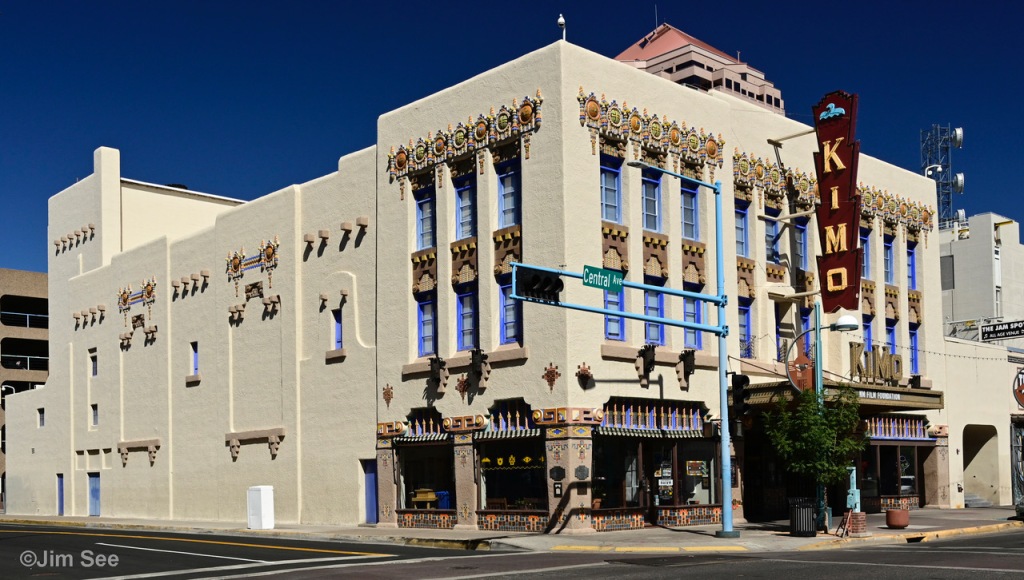Oreste Bachechi first became involved with the movies around 1919, when the Bachechi Amusement Association operated the Pastime Theatre with Joe Barnett. However, by 1925, he had decided to build his own theatre, one that would focus on the American Indian culture of the Southwest in its architectural design. The colors took several months to choose. Like its abstract symbols, color, too, was part of the Native American vocabulary. Red was a somewhat important color because it represents the life-giving sun. White expressed the approaching morning while yellow was representative of the setting sun of the West. Finally, the color black was symbolic of the darkening clouds from the North. The crowning touch was the seven murals painted by Carl Von Hassler. Some of the work he portrayed himself; the rest was traced from heavy butcher paper cut-outs that were taped to the walls and filled in with paint by workmen. Working from a platform hung from the ceiling, Von Hassler reportedly spent months on his creations.
The theater was named the KiMo and opened in 1927. The name is actually a combination of two Indian words meaning “mountain lion” but more often interpreted as “king of its kind.”The theatre cost $150,000 and was completed in less than a year. The elaborate Wurlitzer organ that was used to accompany the silent films shown at that time was an extra $18,000.
The interior included plaster ceiling beams that were textured to look like logs and painted with dance and hunt scenes. The air vents were also disguised as Navajo rugs. The walls were decorated with panoramic murals depicting the Seven Cities of Cibola which were accented by chandeliers that were shaped like war drums and Native American death canoes. However, its most prominent feature was the rows of garlanded longhorn steer skulls with eerie, glowing amber eyes. When the theatre was packed, the balcony, which spans the east to west walls without a center support, was designed to give and sway. It would drop four to eight inches in the middle at peak capacity.
The first movie shown in the KiMo was “Painting the Town Red”, and the first talking movie was “Melody of Broadway.” Frances Farney played the Wurlitzer organ during each performance.
The KiMo was also a significant employer for young people just getting started. Vivian Vance, who gained fame as Lucille Ball’s sidekick in the “I Love Lucy” series, also worked at the KiMo. The theatre hosted such Hollywood stars as Sally Rand, Gloria Swanson, Tom Mix and Ginger Rogers.
A year after the KiMo theater opened, Oreste Bachechi died, leaving the management of the KiMo to his sons. They combined vaudeville and out-of-town road shows with movies and created extra revenue by adding a luncheonette and curio shop on either side of the entrance. In later years, the Kiva-Hi, a second-floor restaurant, and KGGM radio were housed on the second and third floors.
On August 1st, 1951, a water heater exploded during a full showing of Abbott and Costello’s movie “Comin’ Round the Mountain.” Several people were injured, and 6- year-old Bobby Darnall was killed. Apparently, at a particularly scary part, Bobby became so frightened that he ran downstairs at the exact moment a furnace exploded. He was the only one killed.
The 1960’s brought hardship and financial challenges to the theater. The KiMo fell into disrepair following the exodus from downtown that so many American cities have experienced. In 1961 the screen of the theater caught fire and was heavily damaged causing the theater to temporarily close. Two years later the main stage was also destroyed by fire but was haphazardly rebuilt.
In December of 1970, the theater is closed. According to the Albuquerque Journal the KiMo, in recent months, has undergone several shifts in viewing policy- adult “art” movies, then, Spanish, then, Spanish-English. However, by October 1972 the KiMo is active and running plays. A review of the play “The Amorous Flea” runs in the Albuquerque Journal. However, the downtown area was being abandoned for uptown shopping centers and twin screen movie houses. The theater struggles to survive.
The final blow comes in November 1974 when the Madowhy Corp and the Mature Pictures Corp file charges against the Commonwealth theaters, who are operating the KiMo, accusing that the KiMo is showing a bogus, unauthorized and illegal copy of the film “The life and times of the Happy Hooker.” The suit sought a permanent injunction and $75,000.00 in damages. By 1975, the old theater is slated for demolition. Within a year, the city of Albuquerque is interested in buying the theater in hopes of repairing it as a part of the revitalization of the downtown area. The Albuquerque Journal ran a short story on September 30, 1976, that reads:
“The City Spirit group said the KiMo is no longer usable as a modern movie theater but might be restored and used for performing arts. In addition to the theater, which remains closed; the building contains two small retail stores and several offices.”
The KiMo was eventually saved in 1977 when the citizens of Albuquerque voted to purchase this historic theater. The second bond to provide matching funds to a federal grant was rejected by the voters, so the City of Albuquerque allocated 1.1 million dollars for a partial renovation.

